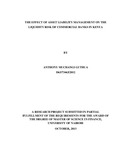| dc.description.abstract | Liquidity is an important determinant of financial distress. The objective of liquidity
management thus is to ensure that banks are able to meet in full all their financial
obligations as they fall due. Banks liquidity is directly affected by asset liability
management decisions in the management of the balance sheet of commercial banks.
Asset liability management involves the management of the total balance sheet dynamics
and it involves quantification of risks and conscious decision making with regard to asset
liability structure in order to maximize the interest earnings within the framework of
perceived risks. The main objective of asset liability management is not to eradicate or
eliminate risk, but to manage it in a way that the volatility of net interest income is
minimized in the short run and economic value of the bank is protected in the long run.
The objective of the study was to investigate the effect of Asset liability management on
the liquidity risk on the commercial banks in Kenya.
The study adopted a descriptive design in its methodology and the researcher chose to
study on commercial banks due to availability of needed data and convenience. All the 43
commercial banks in Kenya were targeted for this study. Secondary data was obtained
from annual Central bank of Kenya Banks supervision reports as well as banks annual
and published financial reports while primary data was also collected by questionnaire
method to supplement the secondary data. Out of the 43 questionnaires issued, 35
questionnaires were returned fully completed representing 81.3%, while 8 questionnaires
were not returned representing 18.6% of the total questionnaires distributed to the
respondents. SPSS version 20.0 was used for data analysis. The test for significance was
t-test and computing the correlation coefficient (r), coefficient of determination and
analysis of variance (ANOVA).
The results of the regression analysis shows that there is a significant positive
relationship between independent variables (return on equity, capital adequacy, loan to
deposit ratio, return on assets, total assets, asset liability management policies, liquidity
stress testing and contingency funding plan) and the dependent variable i.e. liquidity risk
of commercial banks). The findings of the analysis conclude that independent variables
have an effect on the liquidity risk of commercial banks in Kenya.
The research gives the following recommendations for policy: Commercial banks need to
place greater emphasis on developing an integrated view of risks facing the banks; Asset
liability committees and risk managers should implement robust and comprehensive
balance sheet management approaches; management should also ensure there are
effective liquidity management strategies. Lastly, this research study forms the basis for
further research to be extended to other financial institutions that were relevant to the
study such as Microfinance institutions (MFls) but were not covered. A further research
could also be carried out on the role of Asset liability committee with a view to coming
up with recommendation to strengthen its role in the management bank risks. Lastly, a
research could be carried on the factors that influence liquidity levels of commercial
banks in Kenya. | en_US |

